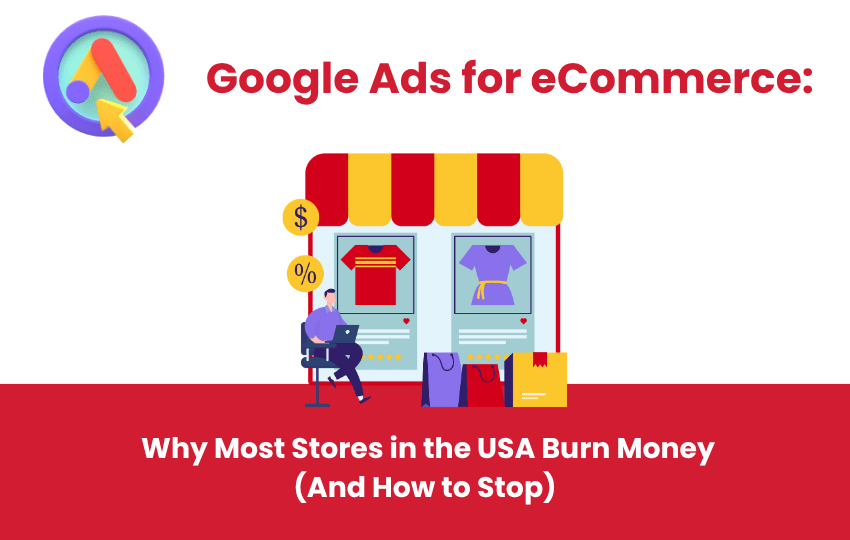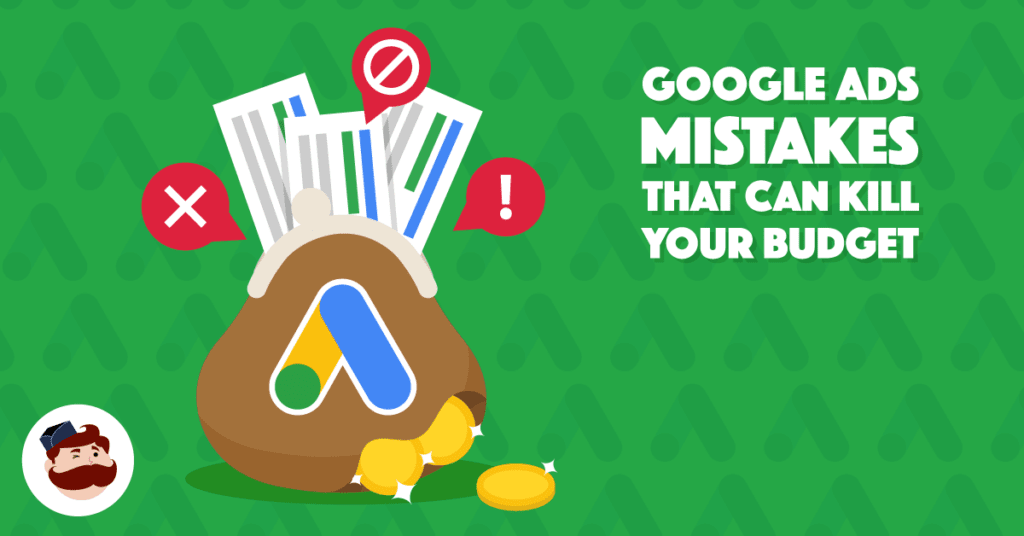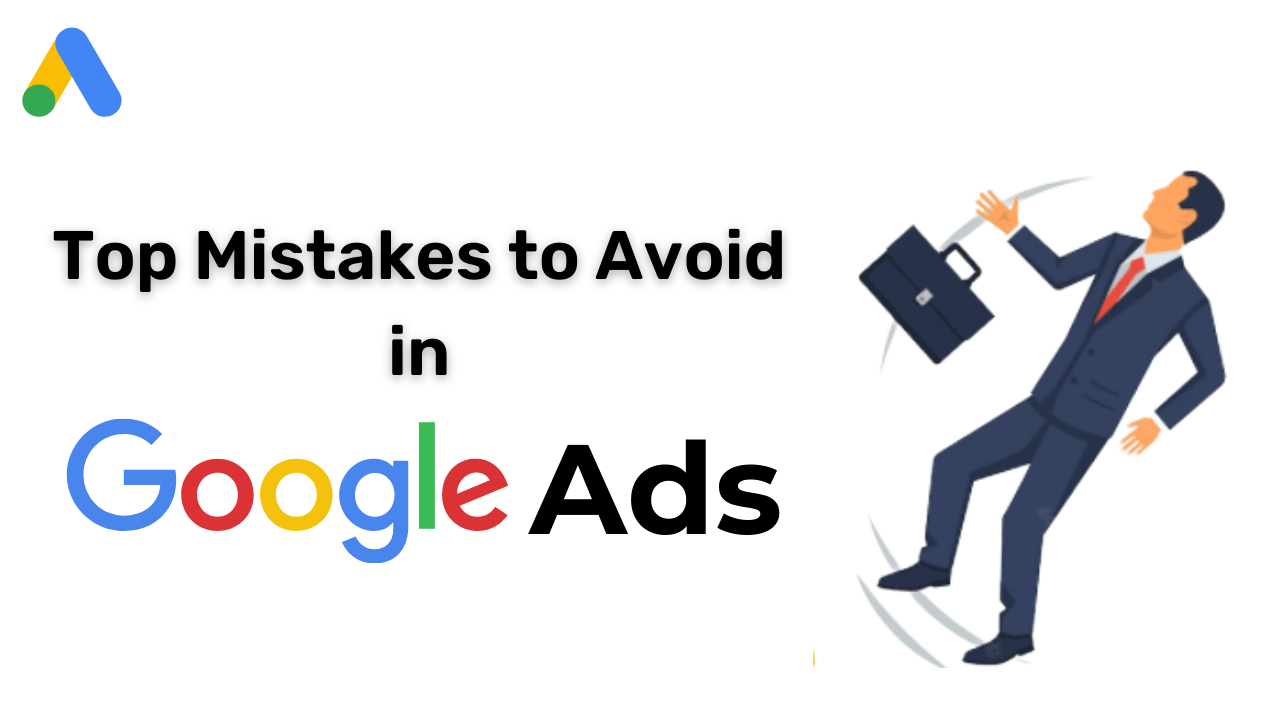
7 Costly Google Ads Mistakes eCommerce Brands in the USA Must Avoid
Running Google Ads for eCommerce in the USA can unlock massive sales potential—but only if done right. Unfortunately, many online stores waste thousands of dollars on poorly structured campaigns, misaligned targeting, weak offers, or neglected optimization. The result? High ad spend with little to no return.
Understanding where e-commerce brands go wrong is the first step toward fixing it. From targeting the wrong audience to ignoring Quality Score or skipping conversion tracking, each mistake chips away at your profitability. Here’s how to identify and fix these errors to boost your Google Ads ROI.

1. You’re Targeting the Wrong Audience for eCommerce Store
Many eCommerce brands waste ad spend by showing ads to people who are not ready or likely to buy.
- Wasted Ad Spend
Targeting broad or irrelevant demographics leads to poor conversions. Your budget gets wasted on users uninterested in your product, and you end up paying for clicks that never turn into sales. Precision in targeting is essential to avoid this pitfall. - Clicks Without Conversions
Misaligned targeting might bring traffic, but not the right kind. If users click but don’t convert, you’re draining your budget with no return. Successful campaigns reach people who are genuinely interested and more likely to take action. - Know Your Audience
Understanding your customer is crucial. Focus on their age, location, behavior, and intent. The more detailed your targeting, the more effective your campaign becomes. Reaching the right people ensures higher engagement, better ROI, and consistent growth for your brand.
For example: Willow Boutique, a beauty brand struggled with stagnant sales until they refined their ad targeting and focused on TikTok Live. By reaching a more relevant audience, they skyrocketed their livestream sales to over $100,000—more than doubling their previous record—and gained 7,800 new followers, proving precision targeting drives real eCommerce results.
2. You’re Using the Wrong Keywords in Google Ads
Keyword selection can make or break your campaign.
- Search Intent Matters
High-volume keywords may look attractive but often lack buying intent. For example, targeting “how to fix a laptop” won’t help if you’re selling laptops. Match your keywords with user intent to increase conversions and reduce bounce rates. - Go for Transactional Keywords
Focus on transactional terms like “buy shoes online” or “best deal on headphones.” These keywords signal strong purchase intent and are more likely to lead to sales compared to informational or navigational keywords. - Avoid Wasted Spend
Broad keywords can trigger irrelevant traffic, leading to wasted ad spend. Use negative keywords, phrase matches, and exact match types to better control which searches trigger your ads and improve overall campaign performance.
Example: Filter King, an air filter eCommerce brand, significantly boosted its revenue by strategically selecting transactional keywords. Through meticulous keyword research and competitor analysis, they identified high-converting terms and optimized their SEO strategy accordingly. This approach led to an impressive $460,000 in revenue, demonstrating the power of targeted keyword selection in driving eCommerce success.
3. Your Landing Page Experience is Weak
Even great ads won’t convert if your landing page disappoints.
- Slow Load Times
A delay of even a few seconds can lead users to bounce. Speed optimization is non-negotiable. Compress images, use lazy loading, and choose fast hosting to improve user experience and increase conversions. - Mismatch Between Ad and Page
The content and offer on your landing page must align with the ad copy. A disconnect between expectation and reality confuses users, erodes trust, and reduces the chance of conversion. Maintain message consistency from click to conversion. - Cluttered or Confusing Layout
A messy or overloaded landing page creates friction. Keep the layout clean with a strong headline, clear benefits, and a single call to action. Mobile responsiveness and intuitive design are also key to keeping users engaged.
For example: Lifepro Fitness revamped their landing pages to enhance user experience and boost conversions. By streamlining design, aligning messaging with ads, and incorporating persuasive elements like celebrity endorsements and clear CTAs, they achieved conversion rates up to 59%, demonstrating the impact of a well-optimized landing page.

4. You’re Not Tracking Conversions Properly
You can’t improve what you don’t measure.
- Flying Blind Without Tracking
If you’re not tracking conversions, you have no idea which ads are working. This results in poor decision-making, misallocated budget, and missed opportunities for optimization. Conversion tracking is critical for performance analysis. - Use the Right Tools
Implement Google Ads Conversion Tracking and integrate with Google Analytics 4. Track meaningful actions like purchases, form submissions, and add-to-cart events to understand true performance. - Optimize Based on Data
Proper tracking lets you double down on what’s working. Analyze data to identify high-converting keywords, ads, and audiences. Use this information to continuously refine your campaigns and maximize your ROI.
For example: In 2023, the global online shopping cart abandonment rate reached 70.19%, crossing the 70% mark for the first time in a decade. This rate has been growing constantly, rising from 68.07% in 2014 to 69.99% in 2022.
5. Your ecommerce Ad Copy Isn’t Compelling
Your copy must grab attention and persuade.
- Generic Copy Fails
Boring, vague, or overly technical ad copy doesn’t inspire action. Your audience scrolls past unless you give them a reason to stop. Use emotional triggers, benefit-driven language, and clear value propositions to make an impact. - Highlight Benefits, Not Just Features
Users don’t care about product specs until they know what’s in it for them. Focus on outcomes and benefits: how does your product solve their problem or improve their life? - Create Urgency and Social Proof
Incorporate time-sensitive offers, limited stock notices, or customer testimonials. These elements create urgency and build trust, increasing your chances of getting the click and conversion.
For example: Ryze Mushroom Coffee used a compelling ad copy to address a common pain point—weight loss—by stating, “LOSE WEIGHT EVEN IF YOU CHEAT.” This bold headline immediately grabs attention and appeals to individuals seeking weight management solutions. The ad also highlighted a limited-time offer, “THIS WEEK ONLY,” creating urgency and encouraging immediate action. Additionally, the visual of a coffee cup with floating coffee beans added intrigue without distracting from the core message. This strategic combination of emotional appeal, urgency, and clear value proposition led to increased conversions and sales.
6. You’re Not Retargeting Visitors
Retargeting is essential to bring back interested users.
- Users Rarely Convert on First Visit
Most shoppers don’t buy the first time they visit. Without retargeting, you’re leaving warm leads behind. Retargeting helps remind them of your product and encourages them to complete the purchase. - Stay Top of Mind
Show tailored follow-up ads to users who visited specific product pages or abandoned carts. Personalization makes your ads more relevant and increases the likelihood of conversion. - Use Smart Offers and Messages
Use dynamic ads to show recently viewed items, offer special discounts, or show positive reviews. These techniques help overcome buyer hesitation and move them closer to a decision.
For example: Nike effectively uses dynamic retargeting ads to re-engage users who have shown interest in specific products. These personalized ads display the exact items users viewed, often accompanied by motivational messages or athlete endorsements, encouraging users to complete their purchase. This approach has led to increased click-through and conversion rates, demonstrating the power of retargeting in driving sales.
7. Google Ads for e-commerce lacks a funnel strategy
A user journey needs to be planned, not left to chance.
- Instant Conversions Are Rare
Expecting a user to buy after one click is unrealistic, especially for high-ticket or new products. Users need time to trust your brand, compare options, and understand your value. - Build Funnel Stages
Design a marketing funnel that leads users from awareness to consideration to purchase. This can include top-of-funnel blog posts, middle-funnel product videos, and bottom-funnel retargeting with special offers. - Nurture Leads Effectively
Use lead magnets, email marketing, and remarketing to nurture potential customers. A well-built funnel builds brand trust and encourages action when the user is finally ready to buy.
For example, Glossier, the beauty brand, built a strong funnel strategy by creating engaging blog content and social media posts to raise awareness, followed by product tutorials and reviews to nurture interest. They then retargeted warm leads with personalized offers, resulting in higher conversion rates and loyal customers.
Bonus: The Offer Itself Isn’t Attractive
Sometimes, the problem isn’t the ads, it’s the offer.
- Evaluate Product-Market Fit
If your product doesn’t solve a real problem or meet a need, no ad can fix that. Study customer pain points and ensure your offer provides clear, compelling value. - Competitive Pricing Matters
Pricing that’s too high or too low can deter customers. Compare with similar offerings in the market and adjust accordingly. Highlight what sets you apart to justify your price. - Craft an Irresistible Value Proposition
Combine urgency, discounts, guarantees, and strong CTAs to make your offer hard to resist. Show users exactly why they should act now instead of postponing their purchase.
Final Thoughts
Cybez understands what it takes to run profitable Google Ads e-commerce in the United States of America. With years of hands-on experience and data-backed strategies, Cybez helps brands eliminate wasteful spending and scale what actually works.
From refining audience targeting to optimizing landing pages and tracking every conversion, the goal is to make every dollar count. If you’re tired of burning money on campaigns that don’t deliver, it’s time to partner with experts who focus on ROI-driven results.
Let Cybez help e-commerce stores reach new heights with smarter, sharper Google Ads campaigns. Explore the best digital marketing agency in the USA now!

